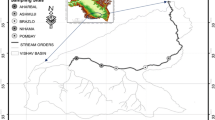Abstract
Water quality data parameters consist of a large data set. Such a large amount of data incurs great effort in processing and conducting visualization techniques to facilitate the analysis and building of the necessary views for decision makers. The current study included a set of steps to data reduction for 34 parameters during two seasons, at different sites and depths for Mosul Dam Lake, Northern Iraq by using VARCLUS technique. VARCLUS showed that there were seven main clusters during winter with 77% of the total variation in the dataset. Depending on Rratio results indicating that there are 12 parameters could be used to monitoring the water quality and F, SO4 and Li are appears to be more important parameters than among them to predict overall the water quality of the lake for this season. During summer eight main clusters with 79% of the total variation displayed result of summer season. B, Na and S were more significant parameters depending on Rratio among 11 parameters for this season. Each of Li, Ni, S, and total inorganic carbon are dominate parameters during measurement periods. This technique for water quality assessment could be using to reduce by about 64% of water quality data and can support decision-makers by providing an effective and secure tool for managing and monitoring the reservoir.




Similar content being viewed by others
REFERENCES
Al-Ansari, N., Issa, I.E., Sherwani, G., and Knutsson, S., Sedimentaion in the Mosul Reservoir of Northern Iraq, J. Environ. Hydro., 2013, vol. 21, pp. 1–10.
Al-Hamadani, A.A.B. and Khattab, M.F.O., Variation of Characteristic Quality with Depth of Water of Mosul Dam Lake, Rafidain J. Sci., 2005, vol. 16, pp. 104–114.
Al-Kawaz, H.A., Geochemistry and Mineralogy of Recent Sediments and Miocene Rocks and the Nature of Their Interaction with the Southern Part of Saddam Lake Waters, Mosul Univ., 1996.
Al-Taiee, T.M. and Sulaiman, Y.I., Preliminary Water Balance of Saddam Dam Lake, in The Second Sci. Conf. SDRC, 1990, pp. 121–134.
Aral, H. and Vecchio-Sadus, A., Toxicity of lithium to humans and the environment—A literature review, Ecotoxicol. Environ. Saf., 2008, vol. 70, pp. 349–356. https://doi.org/10.1016/j.ecoenv.2008.02.026
Chuco, T.D., Dynamic Integrated Modelling of Basic Water Quality and Fate and Effect of Organic Contaminants in Rivers, Gent Univ., 2004.
Hamid, A., Bhat, S., Bhat, S., and Jehangir, A., Environmetric techniques in water quality assessment and monitoring: A case study, Environ. Earth Sci., 2016, vol. 75. https://doi.org/10.1007/s12665-015-5139-3
Hing, K.L.K., An Investigation of Artificial Immune Systems and Variable Selection Techniques for Credit Scoring, RMIT University, 2008.
Iraqi Ministry of Water Resources, Water Resources, Mosul dam Characteristics, 2013. http://www. mowr.gov.iq/?q=node/406
Kelley, J.R., Wakeley, L.D., Broadfoot, S.W., Pearson, M.L., McGrath, C.J., McGill, T.E., and Talbot, C.A., Geologic setting of Mosul Dam and its Engineering Implication, 2007.
Khattab, M.F.O. and Merkel, B.J., Distribution of hetrotrophic bacteria and water quality parameters of Mosul Dam Lake, Northern Iraq, in Water Pollution XI, Brebbia, C.A., Ed., Southampton: WIT Press 2012, pp. 195–207.
Mehling, W.E., Acree, M., Stewart, A., Silas, J., and Jones, A., The multidimensional assessment of interoceptive awareness, Version 2 (MAIA-2), PloS One, 2018, vol. 13, no. 12, e0208034–e0208034. https://doi.org/10.1371/journal.pone.0208034
Nelson, B.D., Variable Reduction for Modeling using PROC VARCLUS, 2001. Retrieved January 1, 2014, from www2.sas.com/proceedings/sugi26/p261–26.pdf.
Saleh, D.K., Stream Gage Descriptions and Streamflow Statistics for Sites in the Tigris River and Euphrates River Basins, Iraq, Reston, Virginia: U.S. Geological Survey, 2010.
Sanche, R. and Lonergan, K., Variable reduction for predictive modeling with clustering, Casualty Actuarial Society Forum, 2006, pp. 89–100.
Shugar, G., Bauman, J., Shari, L., Drum, D.A., and Lauber, J., Environmental Field Testing and Analysis Ready Reference Handbook, McGraw-Hill Professional, 2000.
Sullivan, A.B., Sogutlugil, I.E., Rounds, S.A., and Deas, M.L., Modeling the water-quality effects of changes to the Klamath River upstream of Keno Dam, Oregon, 2013. Retrieved from http://pubs. usgs.gov/sir/2013/5135/.
Udo, T., McKee, S.A., White, M.A., Masheb, R.M., Barnes, R.D., and Grilo, C.M., The factor structure of the metabolic syndrome in obese individuals with binge eating disorder, J. Psychosom. Res., 2014, vol. 76, no. 2, pp. 152–157. https://doi.org/10.1016/j.jpsychores.2013.10.007
Woolston, A., Tu, Y.-K., Baxter, P.D., and Gilthorpe, M.S., A comparison of different approaches to unravel the latent structure within metabolic syndrome, PloS One, 2012, vol. 7, no. 4, e34410–e34410. https://doi.org/10.1371/journal.pone.0034410
ACKNOWLEDGMENTS
This work was supported by the German Academic Exchange Service. The authors would like to express their sincere appreciation to Hazim Al-Naemi for assisting in the achievement of the field work, also Dr. Khalid J. Aswad for offering valuable advice in the statistics field. They are grateful to the administration department of economic computer science especially to Claudia Koschtial for her great help with the program SAS.
Author information
Authors and Affiliations
Corresponding authors
Rights and permissions
About this article
Cite this article
Mohammed F. O. Khattab, Al-Muqdadi, S.W., Abo, R.K. et al. Variable Reduction for Water Quality Investigation using VARCLUS Technique. A Case Study of Mosul Dam Lake, Northern Iraq. Water Resour 47, 1005–1011 (2020). https://doi.org/10.1134/S0097807820060093
Received:
Revised:
Accepted:
Published:
Issue Date:
DOI: https://doi.org/10.1134/S0097807820060093




